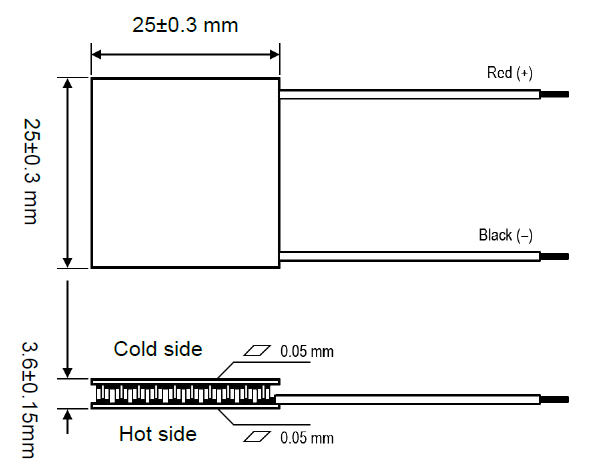*Image
above is for illustration
purpose only..
ATS-TEC25-39-061
TEC Module
Thermoelectric devices are semiconductor heat or refrigeration units which use the Peltier effect to create a heat flux between the two surfaces of the module. When a DC current is applied to the circuit, a thermoelectric module can work as a cooler or heater depending on the direction of current. A thermoelectric cooler (TEC), or solid state heat pump, transfers heat from one side of the device to the other side against the temperature gradient.
Features & Benefits
- High efficiency, high performance
- No sound or vibration
- Compact structure, small in size, light in weight
- Precise temperature control
- Environmentally friendly
- RoHS compliant
- Exceptionally reliable
Product Details
L=Length (mm);W=Width (mm); H=Height (mm);W (g)=Weight (g); Internal resistance (Ω)=Measured by AC 4-terminal method at 27°C; Imax=Maximum current at ΔTmax; Vmax=Maximum voltage at ΔTmax; Qmax=Maximum cooling capacity at Imax.,Vmax. and ΔT=0°C.;
ΔTmax=Maximum temperature difference at Imax.,Vmax. and Qmax=0 W;
| Part Number | Lifecycle
Status | Dimension (mm) | Weight
(gr) | Internal resistance (Ω) | Imax (A) | Vmax (V) | Qmax (W) | ΔTmax (℃) |
|---|
| L | W | H | Th=27℃ | Th=50℃ | Th=27℃ | Th=50℃ | Th=27℃ | Th=50℃ | Th=27℃ | Th=50℃ | Th=27℃ | Th=50℃ |
|---|
| ATS-TEC25-39-061 | ACTIVE | 25 | 25 | 3.6 | N/A | 0.16 | 0.17 | 18 | 18 | 3.75 | 4.15 | 39.7 | 44.1 | 67 | 74 |
Thermal Performance
| Schematic Image
|

*Image above is for illustration purpose only.
|
ATS-TEC25-39-061
(Data Sheet)
|

|
|
|
|
Complete Your Liquid Loop with ATS
ATS has the products needed to design a complete liquid cooling loop : iCDMs (Industrial Cooling Distribution Modules), Tubed and High Performance Cold Plates to transfer and remove the heat from the source; Heat Exchangers to transfer heat from the liquid to the air with or without a fan; Chillers to circulate and condition the fluid in the system, Compact Refrigeration Modules for very high capacity cooling. In addition , ATS offers Flow Meters to measure the volumetric flow rate of the fluid in the system and Leak Detectors to notify users of any leaks in the system.